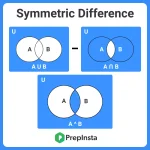symmetric_difference() of Sets in Python
symmetric_difference() of Sets in Python
The symmetric difference of two sets A and B, written as A ^ B is a set which contains all elements of set A and B that are not in their intersection ( common in both set A and B ).
^ symbol denotes symmetric difference of sets.

symmetric_difference() of sets
In Python, you can find the symmetric difference of sets using the symmetric_difference() method or the ^ operator. The symmetric difference between two sets contains the elements that are present in either of the sets but not in both sets.
Let us understand this with an example :
- A = { 1, 2, 3, 4, 5, 6, 7, 8 }
- B = { 3, 6, 9, 12, 15 }
- A ^ B = { 1, 2, 4, 5, 7, 8, 9, 12, 15 }
Explanation :
- A ∪ B = { 1, 2, 3, 4, 5, 6, 7, 8, 9, 12, 15 }
- A ∩ B = { 3, 6 }
- A ^ B = (A ∪ B) – (A ∩ B)
- A ^ B = { 1, 2, 3, 4, 5, 6, 7, 8, 9, 12, 15 } – { 3, 6 }
- A ^ B = { 1, 2, 4, 5, 7, 8, 9, 12, 15 }

Syntax :
Return Type :
The symmetric_difference() method returns symmetric difference between two sets, which is equal to the elements present in either of the two sets, but not common to both the sets.
Using the ^ Operator
#symmetric difference of sets using ^ operator
#example 1
set1 = {'P', 'Y', 'T', 'H', 'O', 'N' }
set2 = {'C', 'O', 'D', 'I', 'N', 'G' }
#common elements {'O','N'} will be removed
print( set1 ^ set2 )
#example 2
A = { 2, 4, 6, 8, 10, 12 }
B = { 3, 6, 9, 12, 15 }
#common elements {6, 12} will be removed
print( A^B )
Output :
{'G', 'H', 'I', 'P', 'Y', 'T', 'C', 'D'}
{2, 3, 4, 8, 9, 10, 15}
Using symmetric_difference() method
#symmetric difference of sets using symmetric_difference() method
#example 1
set1 = {'P', 'Y', 'T', 'H', 'O', 'N' }
set2 = {'C', 'O', 'D', 'I', 'N', 'G' }
#common elements {'O','N'} will be removed
print( set1.symmetric_difference(set2) )
#example 2
A = { 2, 4, 6, 8 , 10 }
B = { 1, 2, 3, 4, 5, 6 }
#common elements {2, 4, 6} will be removed
print( A.symmetric_difference(B) )
Output :
{'G', 'H', 'I', 'P', 'Y', 'T', 'C', 'D'}
{1, 3, 5, 8, 10}
Prime Course Trailer
Related Banners
Get PrepInsta Prime & get Access to all 200+ courses offered by PrepInsta in One Subscription
Get over 200+ course One Subscription
Courses like AI/ML, Cloud Computing, Ethical Hacking, C, C++, Java, Python, DSA (All Languages), Competitive Coding (All Languages), TCS, Infosys, Wipro, Amazon, DBMS, SQL and others





Login/Signup to comment